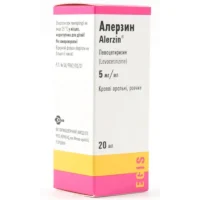Description
Edem (Desloratadine) Coated Tablets 5 mg. №30
Composition
Active ingredient: Desloratadine 5 mg.
Other ingredients: lactose monohydrate, maize starch, talc, magnesium stearate, hypromellose, titanium dioxide (E171), macrogol 400.
Mechanism of Action
Desloratadine, the active ingredient in Edem tablets, acts as a second-generation antihistamine by selectively antagonizing peripheral H1 receptors, effectively blocking the action of histamine in the body.
Pharmacological Properties
Desloratadine exhibits potent antihistaminic properties with minimal sedative effects due to its selective peripheral H1-antagonist activity. It does not easily penetrate the blood-brain barrier, reducing the risk of central nervous system side effects.
Indications for Use
Edem (Desloratadine) coated tablets are indicated for the relief of symptoms associated with allergic rhinitis (hay fever) and chronic idiopathic urticaria.
Contraindications
Do not use Edem (Desloratadine) coated tablets if:
- You are allergic to desloratadine or any other ingredients in the product.
- You have severe liver disease.
Side Effects
Common side effects may include headache, fatigue, dry mouth, and gastrointestinal disturbances. If any severe reactions occur, discontinue use and seek medical advice.
Usage Instructions
For Adults and Children over 12 years: Take one tablet once daily with water, with or without food. Follow the dosage instructions provided by your healthcare provider or as directed on the package. Do not exceed the recommended dose.
Benefits Compared to Analogues
Edem tablets offer 24-hour relief from allergy symptoms with minimal sedation compared to first-generation antihistamines. Their once-daily dosing regimen provides convenience and improved compliance for individuals with allergic conditions.
Suitable Patient Groups
Edem (Desloratadine) coated tablets are suitable for adults and children over 12 years old. They are well-tolerated and have a low risk of causing drowsiness, making them a preferred choice for individuals requiring long-term allergy management.
Storage Conditions and Shelf Life
Store Edem tablets in a cool, dry place away from direct sunlight. Keep them out of reach of children. Check the expiration date on the packaging and do not use the product after the specified date.
Packaging Description
Each package of Edem (Desloratadine) coated tablets contains 30 tablets. The tablets are coated for easy swallowing and protection of the active ingredient.
Clinical Evidence and Proven Effectiveness
Desloratadine has been extensively studied for its efficacy in reducing symptoms of allergic rhinitis and chronic idiopathic urticaria. Clinical trials have demonstrated its ability to improve quality of life and reduce the impact of allergy symptoms on daily activities. The low incidence of sedation makes it a favorable choice for long-term use.





